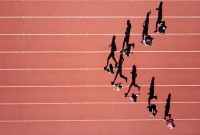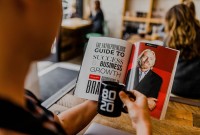- Home
- Business Processes
- Industry Knowledge
- Aerospace Industry
- Automotive Industry
- Banking Domain
- BFSI Industry
- Consumer/ FMCG Industry
- Chemicals Industry
- Engineering & Construction
- Energy Industry
- Education Domain
- Finance Domain
- Hospitality Domain
- Healthcare Industry
- Insurance Domain
- Retail Industry
- Travel and Tourism Domain
- Telecom Industry
- Leadership Skills
- eLearning
- Home
- Leadership
- Communication Skills
- Cognitive Resource Theory
Cognitive Resource Theory
The cognitive resource theory states the influence of the leader's resources on his or her reaction to stress. The cognitive resources of a leader are experience, intelligence, competence, and task-relevant knowledge. Stress is common in resource managing situations, and this cognitive theory emphasizes how intelligence and experience are each best under different stress situations. This theory is the reconceptualization of the Fiedler model.
In the early 1990s, the original model of Fiedler was re-conceptualized by Fiedler and his associate Joe Garcia, as Cognitive Resource Theory. In this model, the focus has been laid on the role of stress as a form of situational un-favorableness and how a leader’s intelligence and experience influence her/his reaction to stress.
What is meant by cognition?
Cognition is the mental action or process of acquiring knowledge and understanding through thought, experience, and the senses. Good examples of cognition are learning and our ability to reason through logic. Cognitive processes use existing knowledge and generate new knowledge. Cognitive processes are analyzed from different perspectives within different contexts like psychiatry, psychology, education, philosophy, and computer science.
Cognitive Resource Theory of Leadership
The Contingency Model developed by Fiedler was criticized for its lack of flexibility and also over the accuracy of the LPC scale. Fiedler then went on to develop the Cognitive Resource Theory (CRT) which takes into account the personality of the leader, degree of situational stress, and group-leader relations.
The assumption behind this theory is that stress impacts the ability to make decisions. It is the enemy of rationality and a leader cannot think in a logical and analytical manner if she/he is under a high level of stress. According to this proposition, the importance of a leader’s intelligence and experience to effectiveness differs under low and high-stress situations.
Fiedler and Gracia state that a leader’s intellectual ability correlates positively with performance under low stress but negatively under high stress. And conversely, a leader’s experience correlates negatively with performance under low stress but positively under high stress.
Thus, according to Fiedler and Gracia, the level of stress in a situation, determines whether an individual’s intelligence or experience will contribute to leadership performance.
Predictions of Cognitive Resource Theory
The Cognitive Resource theory predicts that the leader's abilities and intelligence can aid organizational success only when leaders adopt a directive leadership style, the situation is stress-free, the group members are supportive and the task requires high intellect. These attributes are discussed below:
1. Directive Approach
When a leader is better in cognitive abilities like intelligence, planning, and decision-making, he must follow a directive approach to improve the overall performance of the team. He needs to communicate to the group what to do, to ensure his plans and decisions are implemented, hence improving the overall performance of the group.
When the group and the people on the group are better than the leader in cognitive abilities, then the leader should choose a non-directive approach. He should seek ideas from the group and identify the best approach/idea and move ahead with the same.
A leader's cognitive ability contributes to the performance of the team only when the leader uses the directive leadership style.
2. Impact of Stress
Stress has a direct co-relation with intelligence and decision quality.
When there is a low stress, then intelligence is fully functional and makes an optimal contribution.
When there is high stress, natural intelligence does not make any difference, but may also have a negative effect.
3. Supportive Group Members
A leader's abilities will contribute to group performance only when group members are supportive of the leader and his goals. In such a situation leader's directions can be easily followed and implemented.
4. Cognitively Demanding Tasks
The intellectual abilities and intelligence of the leader can only be utilized efficiently in difficult, cognitively demanding tasks.
What are the practical applications of Cognitive Resource Theory?
The theory proposes the style of leadership required depending on three variables – the degree of stress, situational control, and task structure.
Leaders should be trained on stress management so that a leader's intellect can be most effectively utilized and also to train leaders to take a directive approach when their knowledge will benefit the group but a less directive approach when group member abilities will contribute to performance.
Based on this theory, for a given situation, depending on the level of the stress, leaders can decide on whether to rely on intelligence or on experience. For low-stress situations, one should rely on intelligence; however, for high-stress situations, one should rely on experience.
In high-stress situations, leaders who are more experienced will produce more quality results. In high-stress situations, rational solutions are generally not available and hence intelligence will not be able to support the decision-making process, whereas previous experience can allow the leader to react.
What are the cognitive resources of the self?
The cognitive resources of a leader refer to their experience, intelligence, competence, and task-relevant knowledge. A leader's knowledge can contribute to performance if it is efficiently communicated, hence requiring a directive leader and also a compliant group that is willing to undertake the commands of the leader.
Related Links
You May Also Like
-
Process & Stages of Creativity
Creative ideas do not come just like that. There is a process to it. There are a number of techniques of creativity to support the generation of ideas but the widely practiced ones are brainstorming and lateral thinking. Most innovations are not so much the product of sudden insights as they are the result of a conscious process that often goes through multiple stages. The creative process can be divided into four stages of preparation, incubation, evaluation, and implementation.
-
The cognitive resource theory states the influence of the leader's resources on his or her reaction to stress. The cognitive resources of a leader are experience, intelligence, competence, and task-relevant knowledge. Stress is common in resource managing situations, and this cognitive theory emphasizes how intelligence and experience are each best under different stress situations. This theory is the reconceptualization of the Fiedler model.
-
Situational Theories of Leadership
The situational theories of leadership assume that the most effective style of leadership depends from situation to situation. Situational leadership is a leadership style in which the leader must adjust to match the development needs of the followers. They must adapt varying behaviors to strike the right balance between task & relationship based on different levels of maturity of followers and also as followers develop and cultivate their skills.
-
David Kolb produced this popular model for learning in 1984. The model suggests four stages of learning which most learners go through in order to learn effectively. Leaming is itself a process of change. Something is added to our perception and prepared us for the next impression, which will change our understanding yet more, however minutely. The Kolb contribution is a significant one because it practically equates change and learning.
-
The Vroom-Yetton model is designed to optimize for the current situation the leadership style for best decision-making. Its a decision model formulated with contribution from Arthur Jago on how to make group decisions. The leader must gather information from the team prior to making the decision and involves more people in the decision process.
-
Transactional Analysis also is known as the theory of human personality was proposed by Eric Berne in the 1950s. This theory of transactional leadership defines three different ego states in a person who engages in transactions with another person's ego states. These three ego states refer to major parts of an individual's personality and reflect an entire system of thought, feeling, and behavior.
-
The skills approach to leadership suggests that certain skills are important for effective leadership. Skills are what leaders can learn and develop, whereas traits are innate characteristics. The main skills needed for leadership, according to one such theory, are technical, human, and conceptual.
-
There are four characteristics of leadership that help us to understand the character of leadership as a concept. 1. Leadership is a process, 2. Leadership involves influence, 3. Leadership always occurs in a group context and 4. Leadership involves goal attainment. These are the four components that make up the character of the 'leadership' term and help us to define the leadership concept. All of these components of leadership have common characteristics.
-
Leadership Participation Inventory (LPI)
Kouzes and Posner introduced the Leadership Participation Inventory model of Transformational leadership. This model is also known as Kouzes and Posner's Leadership Challenge Model. They identified five practices of exemplary leadership - Model the Way, Inspire a Shared Vision, Challenge the Process, Enabling Others to Act, and Encourage the Heart.
-
Five Factors Model (FFM) also known as Five-Factor Personality Model is based on five broad personality traits which are extraversion, neuroticism, openness to experience, agreeableness, and conscientiousness represented by acronym OCEAN, these traits are often referred to as the “Big Five”.
Explore Our Free Training Articles or
Sign Up to Start With Our eLearning Courses

About Us
Learning
© 2023 TechnoFunc, All Rights Reserved










